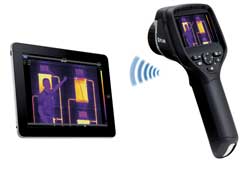
Posted to News on 2nd May 2012, 09:59
New applications for thermal imaging
Andrew Baker, the UK and Ireland Sales Manager for Flir Systems, discusses recent developments in thermal imaging and what the future holds.

Thermal imaging has proved its worth across industry and the continuing high demand for cameras is testimony to that. But where does the technology go from here? An important area of development is related to how widely thermal imaging cameras are being used.
For most, a thermal imaging camera is an essential piece of kit that is used daily, not just housed in a cupboard for an occasional inspection. This means it must be fit for purpose and designed to withstand the rigours of industrial environments. As a result, new cameras are becoming much more robust than their forerunners and are, for example, subjected to stringent drop tests to confirm their durability.
Wider choice
The choice of models, in terms of camera performance and dedicated applications features, has never been greater. There is now a model on the market to suit every level of sophistication and analysis and reporting needs. This is important because as users work with the technology they naturally discover new applications for it.
So, for example, even though an engineer may start with a fixed-lens model, the benefits of having interchangeable lenses for various applications will become apparent. And there is a wealth of choice, enabling users to upgrade their cameras in line with their evolving experience and expertise.
Software
The parallel development of analysis and reporting software is also of significant importance. Again, the choice for asset maintenance is fulsome and starts with simple products that enable users to organise and analyse radiometric images on the camera and quickly present them in a report. Intuitive and easy-to-use online tools are also available for the same purpose.
Further up the scale are systems that incorporate features such as fusion, trending and provide greater flexibility in report design and layout. And for the professional thermographer, dedicated software enables advanced analysis of systems and structures to be performed. An energy cost comparison report is one example for the easy calculation of achievable cost savings when the identified structural problems are fixed.
Greater functionality
Complementing the breadth of choice is the continuous development of cameras. Even entry-level models now incorporate some highly sophisticated features. The cost of a basic troubleshooting model makes it affordable across all engineering disciplines and the performance of these cameras gets better and better.
A good example is the inclusion of wireless technology in thermal imaging cameras. This provides significant application scope, as it enables data from a WiFi-enabled moisture meter or clamp meter to be transferred to the corresponding thermal image. This means, for example, that the relationship between heat and power load can be seen, thereby bringing more intelligence to the inspection process.
This technology also allows thermal imaging cameras to 'talk' to mobile devices such as an iPhone and iPad. The result is far greater application flexibility, as it enables images to be shared with colleagues so that swift decisions can be taken on the remedial action needed to prevent loss of production or to minimise risk.
New applications
Thermal imaging is also proving useful for the maintenance of renewable energy plant. A brake or a gearbox failure in a wind turbine can be catastrophic; uncontrolled speed of rotation imposes excessive loads on the blades and can result in a fracture with life-threatening consequences. Increasingly thermal imaging is being used for preventative maintenance of these vital components.
The technology is able to pinpoint the exact component whose thermal profile indicates an impending fault. It is therefore a reliable, quick and efficient method of identifying signs of wear on all manner of mechanical components, as well as electrical elements such as transformers, connectors and controllers.
The need for training
The entry cost to thermal imaging continues to fall and this is attracting more potential users. But while this is a positive development, it puts even more emphasis on the need for training. Thermal imaging cameras may be getting smarter but that is no substitute for the user fully comprehending the science behind the technology.
Knowing the principles of infrared is a vital part of getting the best return on the camera investment. So at the very least, users are recommended to attend a course that covers the basics and better still, become a Level 1 thermographer. Follow the links for more information about the Flir Infrared Training Center (ITC) and the fundamentals of infrared technology.






























